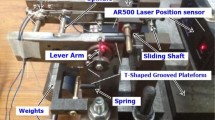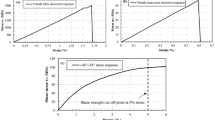Abstract
Voids occurred after the manufacturing process are a common defect of composite materials. They appear to have a negative impact on the matrix-dominated material properties, the gravity of which depends upon the porosity content, the shape and the volume of pores. In the present work, the effects of porosity on the shear mechanical properties of unidirectional carbon fiber-reinforced plastic composites are evaluated via mechanical testing and numerical simulation. In this framework, the V-Notched Rail Shear test method is applied on carbon fiber reinforced plastic specimens of four porosity levels. Moreover, two finite element methodologies are utilized for simulating this particular mechanical test namely the progressive damage model (PDM) and the Virtual Crack Closing Technique (VCCT). Double cantilever beam (mode I) and end notched flexure tests (mode II) are also conducted for the development of the VCCT model. The results from the shear mechanical tests reveal a considerable drop in both the elastic properties and strength. In addition to that, for larger porosity contents, more cracks are present and crack initiation and propagation occur at a faster pace. Finally, the advantages and disadvantages of the two numerical methods are presented and assessed revealing a satisfying consistency with the results obtained by the mechanical tests.

















Similar content being viewed by others
References
Campbell FC (2004) Manufacturing processes for advanced composites. Elsevier Advanced Technology, ISBN 1856174158
Njionhou A, Berthet F, Castanie B (2013) Effects of process parameters on the mechanical properties and morphology of stitched and non-stitched carbon/epoxy liquid resin-infused NCF laminate, out of autoclave and out of oven. Int J Adv Manuf Technol 65:1289–1302
Ricotta M, Quaresimin M, Talreja R (2009) Mode I strain energy release rate in composite laminates in the presence of voids. Compos Sci Technol 68(16):2616–2623
de Almeida FM, Nogueira Neto ZDS (1994) Effect of void content on the strength of composite laminates. Compos Struct 28:139–148
Stamopoulos AG, Tserpes KI, Dentsoras AJ (2018) Quality assessment of porous CFRP specimens using X-ray computed tomography data and artificial neural networks. Compos Struct 192:327–335
Khan M. (1998) Non-destructive testing applications in commercial aircraft maintenance. Proceedings of the 7th European conference on non-destructive testing ECNDT, 26-29 may, Copenhagen, Denmark
Chrysafi A, Athanasopoulos N, Siakavellas NJ (2017) Damage detection on composite materials with active thermography and digital image processing. Int J Therm Sci 116:242–253
Tsuda H (2006) Ultrasound and damage detection in CFRP using fiber Bragg grating sensors. Compos Sci Technol 66(5):676–683
Nikishkov Y, Airoldi L, Makeev A (2013) Measurement of voids in composites by X-ray computed tomography. Compos Sci Technol 89:89–97
ASTM D5379/ D5379M. Standard Test Method for Shear Properties of Composite Materials by the V-notched Beam Method.ASTM International, 1999
ASTM D4255D/ D4255M.Standard Test Method for In-plane Shear Properties of Polymer Matrix Composite Materials by the Rail Shear Method. ASTM International, 2002
Almeida JHS Jr, Angrizzani CC, Botelho EC, Amico SC (2015) (2015) effect of fiber orientation on the shear behaviour of glass fiber/epoxy composites. Mater Des 65:789–795
Adams DO, Moriarty JM, Gallegos AM, Adams DF (2007) The V-notched rail shear test. J Compos Mater 41(3):281–297
Tserpes KI, Stamopoulos AG, Pantelakis SG (2016) A numerical methodology for simulating the mechanical behavior of CFRP laminates containing pores using X-ray computed tomography data. Compos Part B 102:122–133
Stamopoulos A.G., Tserpes K.I, Prucha P., Vavrik D. (2016) Evaluation of porosity effects on the mechanical properties of carbon fiber-reinforced plastic unidirectional laminates by X-ray computed tomography and mechanical testing. J Compos Mater; 50 (15), 2087–2098
ASTM D7078/ D7078M.Standard Test Method for Shear Properties of Composite Materials by V-Notched Rail Shear Method. ASTM International, 2012
ASTM D5528–01. Standard Test Method for Mode I Interlaminar Fracture Toughness of Unidirectional Fiber-Reinforced Polymer Matrix Composites. ASTM International, 2007
Low KO, Teng SM, Johar M, Israr HA, Wong KJ (2009) Mode I delamination behaviour of carbon/epoxy composite at different displacement rates. Composites Part B 176:1072–1093
Sham Prasad MS, Venkatesha CS, Jayaraju T (2011) Experimental methods of determining fracture toughness of Fiber reinforced polymer composites under various loading conditions. Journal of Minerals & Materials Characterization & Engineering 10(13):1263–1275
AITM 1.0006. Carbon Fiber Reinforced Plastics Determination of Interlaminar Fracture Toughness Energy Mode II GIIc Test. Airbus Industrie, 1994
Smiley AJ, Pipes RB (1987) Rate sensitivity of mode II interlaminar fracture toughness in graphite/epoxy and graphite/PEEK composite materials. Compos Sci Technol 29(1):1–15
Colin de Verdiere M, Skordos AA, Walton AC, May M (2012) Influence of loading rate on the delamination response of untufted and tufted carbon epoxy non-crimp fabric composites/Mode II. Eng Fract Mech 96:1–10
Tserpes KI, Papanikos P, Kermanidis A (2001) A three-dimensional progressive damage model for bolted joints in compositpe laminates subjected to tensile loading. Fatigue & Fracture of Engineering Materials & Structures 24:663–675
Chang FK, Chang KY (1987) A progressive damage model for laminated composites containing stress concentrations. J Compos Mater 21:834–855
Chen JF, Mozorov EV, Shankar K (2014) Progressive failure analysis of perforated aluminium/CFRP fibre metal laminates using a combined elastoplastic damage model and including delamination effects. Compos Struct 114:64–79
ANSYS User's manual, version 11. Pittsburgh, PA, USA: Swanson Analysis Systems; 2008
Chamis C.C. (1984) Mechanics of composite materials: past, present and future. NASA technical memorandum 100793, in: 21st annual meeting of the Society for Engineering Science, October 15–17 , Blacksburg, Virginia, USA
Daniel I.M., Ishai O. (1994) Engineering mechanics of composite materials. Oxford University press; 0-19-507506-4
Hashin Z (1980) Failure criteria for unidirectional fiber composites. J Appl Mech 47(2):329–334
Irissari FX, Laurin F, Carrere N, Maire JF (2012) Progressive damage and failure of mechanically fastened joints in CFRP laminates – part II: failure prediction of an industrial junction. Compos Struct 94:2278–2284
Shivakumar KN, Tan PW, Newman JC Jr (1988) A virtual crack-closure technique for calculating stress intensity factors for cracked three dimensional bodies. Int J Fract 36:43–50
Leski A (2007) Implementation of the virtual crack closure technique in engineering FE calculations. Finite Elem Anal Des 43:261–268
Krueger R (2015) The virtual crack closure technique for modeling interlaminar failure and delamination in advanced composite materials. Woodhead publishing series in composites science and engineering: 3-53
Irwin GR (1958) Fracture I. Handbuch der Physik VI, Flügge: 558–590
Author information
Authors and Affiliations
Corresponding author
Ethics declarations
Conflict of interest
The authors declare that they have no conflict of interest.
Additional information
Publisher’s note
Springer Nature remains neutral with regard to jurisdictional claims in published maps and institutional affiliations.
Rights and permissions
About this article
Cite this article
Stamopoulos, A.G., Psaropoulos, A.P. & Tserpes, K. Experimental and numerical investigation of the effects of porosity on the in-plane shear properties of CFRPs using the V-notched rail shear test method. Int J Mater Form 14, 67–82 (2021). https://doi.org/10.1007/s12289-020-01544-1
Received:
Accepted:
Published:
Issue Date:
DOI: https://doi.org/10.1007/s12289-020-01544-1




